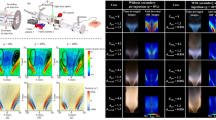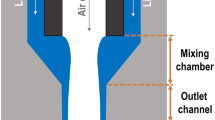Abstract
The spray/wall interaction is considered as an important phenomenon influencing air-fuel mixing in the internal combustion engines. In order to adequately represent the spray/wall interaction process, impingement regimes and post-impingement behavior have been modeled using experimental data and conservation constraints. The modeled regimes were stick, rebound, spread and splash. The tangential velocities of splashing droplets were obtained using a theoretical relationship. The continuous phase was modeled using the Eulerian conservation equations, and the dispersed phase was calculated using a discrete droplet model. The numerical simulations were compared to experimental results for spray impingement normal to the wall. The predictions for the secondary droplet velocities and droplet sizes were in good agreement with the experimental data.
Similar content being viewed by others
Abbreviations
- D :
-
Droplet diameter
- f :
-
Frequency of the impinging droplet
- h :
-
Height of splashing lamella
- K :
-
Non-dimensional parameter (=Oh·Re 1.25 bn )
- m :
-
Droplet mass
- N :
-
Number of droplets in a parcel
- Oh :
-
Ohnesorge number (=ρ d D b v bn /μ d )
- Re:
-
Reynolds number (=μ d /ρ d σ d D b )
- r c :
-
Radius of splashing lamella
- r m :
-
Splashing mass ratio
- v :
-
Velocity of droplet
- We c :
-
Critical Weber number based on the incident droplet velocity
- θ b :
-
Incident angle of impinging droplets measured from the wall
- θ b :
-
Splashing angle of droplets measured from the wall
- σ:
-
Surface tension of the droplet
- ϕ:
-
Time fraction at which the splash occurs
- ν:
-
Kinematic viscosity of the impinging droplet
- a, b :
-
After and before impingement, respectively
- n, t :
-
Normal and tangential, respectively
- d, s :
-
Droplet and splashing, respectively
References
Ahmadi-Befrui, B., Uchil, N, Gosman, A. D. and Issa, R. I., 1996, “Modelling and Simulation of Thin Liquid Films Formed by Spray-Wall Interaction,” SAE 960627.
Arcoumanis, C. and Chang, J-C., 1993, “Heat Transfer Between a Heated Plate and an Impinging Transient Diesel Spray,”Experiments in Fluids, Vol. 16, pp. 105–119.
Arcoumanis, C. and Chang, J-C., 1994, “Flow and Heat Transfer Characteristics of Impinging Transient Diesel Spray,” SAE 940678.
Bai, C. and Gosman, A. D., 1995, “Development of Methodology for Spray Impingement Simulation,” SAE 950283.
Bai, C. and Gosman, A. D., 1996, “Mathematical Modelling of Wall Films Formed by Impinging Spray,” SAE 960626.
Borman, G. L. and Johnson, J. H., 1962, “Unsteady Vaporisation Histories and Trajectories of Fuel Drops Injected into Swirling Air,” SAE 598C.
Eckhause, J. E. and Reitz, R. D., 1955, “Modelling Heat Transfer to Impinging Fuel Sprays in Direct-Injection Engines,”Atomization and Sprays, Vol. 5, pp. 213–242.
Gavaises, M., 1997, “Modelling of Diesel Fuel Injection Processes,” PhD thesis, Imperial College of Science, Technology and Medicine, University of London.
Lee, S. H., 1998, “Development of a New Model and Heat Transfer Analysis of Impinging Diesel Sprays on a Wall,” PhD thesis, Chung-Ang University.
Lee, S. H., Ryou, H. S., 2000, “Modelling of Diesel Spray Impingement on a Flat Wall,”KSME International Journal, Vol. 21, No. 2, pp. 151–173.
Mundo, C., Sommerfeld, M. and Tropea, C., 1995a, “Droplet-Wall Collisions: Experimental Studies of the Deformation and Breakup Process,”Int. J. Multiphase Flow, Vol. 21, No. 2, pp. 151–173.
Mundo, C., Sommerfeld, M. and Tropea, C., 1995b, “Numerical and Experimental Investigation of Spray Characteristics in the Vicinity of a Right Wall,”ICLASS 95, Two Phase Flow Modelling And Experiment, Rome.
Mundo, C., Sommerfeld, M. and Tropea, C., 1998, “On the Modelling of Liquid Sprays Impinging on Surfaces,”Atomization and Sprays, Vol. 8, pp. 625–652.
Naber, J. D. and Reitz, R. D., 1988, “Modelling Engine Spray/Wall Impingement,” SAE 880107.
Nagaoka, M., Kawazoe, H. and Nomura, N., 1994, “Modelling Fuel Spray Impingement on a Hot Wall for Gasoline Engines,”SAE 940525.
O’Rourke, P. J., 1981, “Collective Drop Effects on Vaporizing Liquid Sprays,” PhD thesis, Princeton University, Princeton, NJ.
Park, K., 1994, “Development of a Non-Orthogonal-Grid Computer Code for the Optimization of Direct-Injection Diesel Engine Combustion Chamber Shapes,” PhD thesis, University of Manchester Institute of Science and Technology.
Park, K. and Watkins, A. P., 1996, “Comparison of Wall Spray Impaction Models with Experimental Data on Drop Velocities and Sizes,”Int. Heat and Fluid Flow, Vol. 17, No. 4, pp. 424–438.
Reitz, R. D., 1987, “Modelling Atomization Processes in High-pressure Vaporizing Sprays,”Atomization and Spray Tech, Vol. 3, pp. 309–337.
Reitz, R. D. and Diwakar, D., 1987, “Structure of High Pressure Fuel Sprays,” SAE 870598.
Reynolds, W. C., 1980,Modelling of Fluid Motions in Engines-an Introductory Overview, in Combustion Modelling in Reciprocating Engines, ed. J. N. Mattavi and C. A. Amann, Plenum Press, NY.
Rodrigues, F. and Mesler, R., 1985, “Some Drops Don’t Splash,”J. of Colloid and Interface Science, Vol. 106, No. 2, pp. 347–352.
Schunemann, E., Fedrow, S. and Leipertz, A., 1998, “Droplet Size and Velocity Measurements for the Characterization of a DI Diesel Spray Impinging on a Flat Wall,” SAE 982545.
Senda, J., Kobayashi, M., Iwashita, S. and Fujimoto, H., 1994, “Modelling of Diesel Spray Impingement on a Flat Wall,” SAE 941894.
Senda, J., Kanda, T., Al-Roub, M., Farrell, P. V., Fukami, T. and Fujimoto, H., 1997, “Modelling Spray Impingement Considering Fuel Film Formation on the Wall,” SAE 970047.
Stanton, D. W. and Rutland, C. J., 1996, “Modelling Fuel Film Formation and Wall Interaction in Diesel Engines,” SAE 960628.
Stanton, D. W. and Rutland, C. J., 1998, “Multi-dimensional Modelling of Thin Liquid Films and Spray Wall Interactions Resulting from Impinging Sprays,”Int. J. Heat and Mass Transfer, Vol. 41, pp. 3037–3054.
Watchters, L. H. J. and Westerling, N. A. J., 1966, “The Heat Transfer from a Hot Wall to Impinging Water Drops in a Spheroidal State,”Chem. Eng. Sic., Vol. 21, pp. 1047–1056.
Watkins, A. P., 1989, “Three-dimensional Modelling of Gas Flow and Sprays in Diesel Engines,”In Computer Simulation of Fluid Flow, Heat and Mass Transfer and Combustion in Reciprocating Engines, N. C. Markatos (ed), Hemisphere, Bristol, PA, pp. 193–237.
Watkins, A. P, and Wang, D. M., 1990, “A New Model for Diesel Spray Impaction on Walls and Comparison with Experiment,”Int. Symp. on Diagnostics and Modelling of Combustion in IC Engines, Kyoto, pp. 243–248.
Xiong, T. Y. and Yuen, M. C., 1991, “Evaporation of a Liquid Droplet on a Hot Plate,”Int. J. Heat and Mass Transfer, Vol. 34, No. 7, pp. 1881–1894.
Yarin, A. L. and Weiss, D. A., 1995, “Impact of Drops on Solid Surfaces: Self-similar Capillary Waves and Splashing as a New Type of Kinematic Discontinuity,”J. Fluid Mech., Vol. 283, pp. 141–173.
Author information
Authors and Affiliations
Corresponding author
Additional information
First Author
Rights and permissions
About this article
Cite this article
Yang, H.C., Park, S.K. A study on the behavior and heat transfer characteristics of impinging sprays. KSME International Journal 15, 374–383 (2001). https://doi.org/10.1007/BF03185221
Received:
Revised:
Issue Date:
DOI: https://doi.org/10.1007/BF03185221




